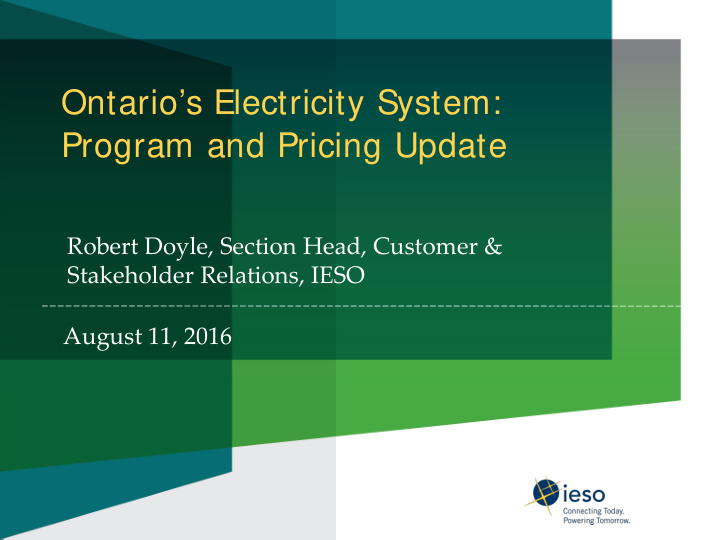



Ontario’s Electricity System: Program and Pricing Update Robert Doyle, Section Head, Customer & Stakeholder Relations, IESO August 11, 2016
Who We Are and What We Do The Independent Electricity System Operator (IESO) ensures there is enough power to meet the province's energy needs in real time while also planning and securing energy for the future. It does this by: • Long term and short term planning • Enabling conservation by overseeing funding of Save on Energy programs offered by LDCs • Ensuring supply through contracts, real time energy and operating reserve market and ancillary services such as regulation and blackstart • Operating the IESO-controlled grid • Engaging stakeholders and communities 2
Current Environment Decisions made over the past decade mean that Ontario demand supply picture will remain positive for the foreseeable future • Adequate supply from a diverse supply mix • Demand expected to remain flat for the long-term • Growth to be offset by conservation savings • Developing a work plan to renew Ontario’s electricity market • Conservation First Framework mid term review 3
Conservation Building a Culture of Conservation 2011-2014 2015-2020 Pre-2011 Conservation Framework Conservation First Success to Date 9.9 billion kilowatt-hours of electricity savings through SOE programs and changes to codes and standards in the past 10 years 6,553 gigawatt-hours of energy savings between 2011 and 2014 through the SOE suite of programs 928 megawatts of demand reduction for the province 9.8 million products purchased using Save on Energy coupons 5,000 people participated in IESO-supported training programs between 2011 and 2014 4
Putting Conservation First • Conservation provides the cleanest and most cost-effective alternative to new generation at less than 4 cents/kWh • Conservation lowers peak demand, deferring or avoiding the need to build 8.7 new infrastructure • Helps Ontarians better manage their energy costs terawatt-hours by the end of 2020 • Favourable return on investment for customers 5 5
Save on Energy Programs Cover All Sectors Residential Home Assistance Small business Institutional Commercial (incl. multi-family) Industrial Agriculture 6
Multi-Distributor Customer P4P Pilot • Strong organizational commitment to energy management • Possess, or are willing to implement at own cost, information systems to monitor building energy performance at minimum on a monthly basis and to have processes in place to monitor and respond to changes • Desire to move beyond simple retrofits • Interested in improving bottom line by managing energy use and associated costs • Currently working with stakeholders to develop the program requirements 7 7
Integrating Demand Response Demand Response (DR) provides an opportunity for customers to participate, reduce consumption and help mitigate costs • DR has reduced peak demand on summer days by as much as 1,200 MW • Transitioning DR to a market mechanism began with moving the DR3 program to the capacity- based DR program • The first DR auction in December 2015; will contribute 391.5 MW for 2016 summer season and 403.7 MW for 2016-17 winter season • DR pilot projects represent up to 80 MW of DR from five companies covering 20 projects ranging from 1 MW to 35 MW 8
Making an Energy Management Plan 9
Analyzing Your Electricity Profile • Understand the measurements • Find your peak demand • Understand the rates
Calculating Avoided Costs Energy efficiency projects have saved 5,000 kWh/month 2016 Total kWh charges: 12.2¢/kWh Avoided Monthly Cost $613.50 11
Wholesale Market Price and Global Adjustment Wholesale Price (HOEP) • Signals current supply and demand situation • Covers operational costs of production – such as fuel • Varies by hour and impacted by weather, time of day, year or day of the week Global Adjustment • Investment or capacity costs to build or refurbish infrastructure – that are not covered through market revenues • Includes contracts, and regulated rates to generators and other suppliers as well as conservation • Generally speaking, when the HOEP is lower, then the GA is higher in order to cover all system costs. • The GA also changes when new projects come into service, contract payments take effect or as a result of changes in demand 12 12
Electricity Pricing Trends 12 10 8 ¢/ kWh 6 4 2 0 2008 2009 2010 2011 2012 2013 2014 2015 2016 (Jan-Jun) Average Ontario Energy Price (kwh) Average Weighted Global Adjustment 13
Global Adjustment by Components 10
Industrial Conservation Initiative (ICI) • www.ieso.ca/peaktracker 15 15
I ESO Resources – Keep eep in Touch 16
Recommend
More recommend